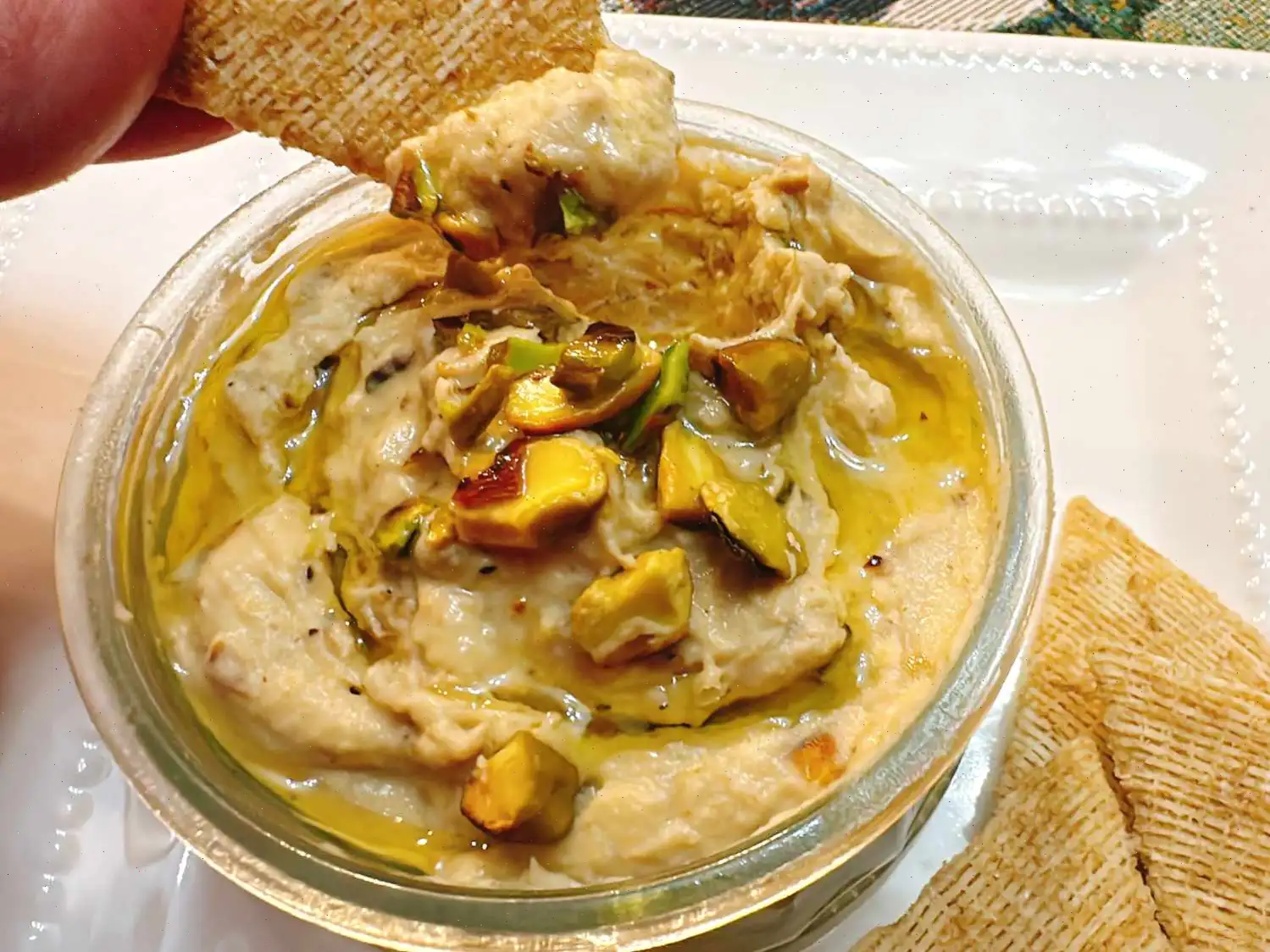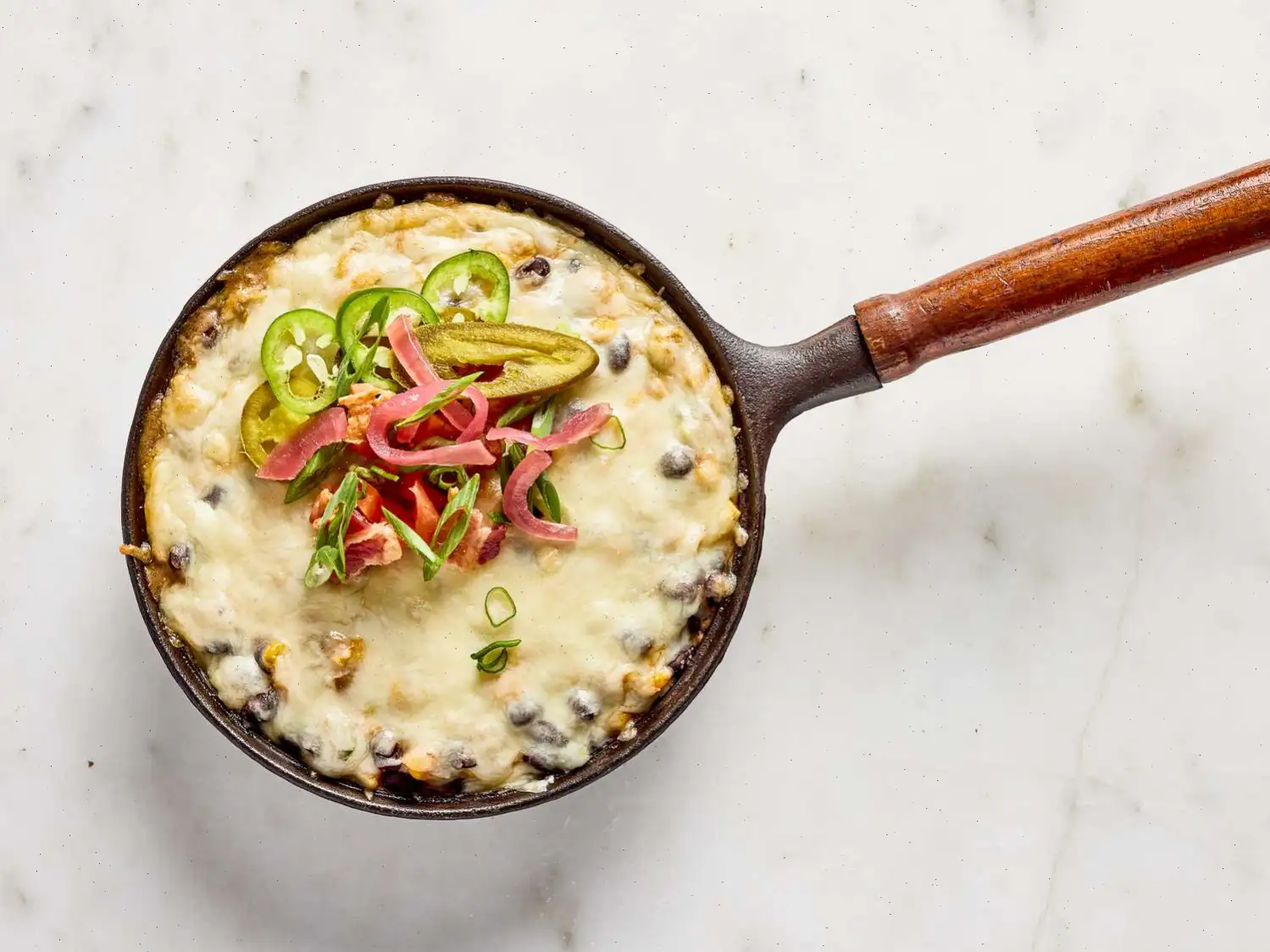
Pistachio Hummus Recipe
Recipe
This recipe yields 12 servings.
Ingredients
- 1/2 cup pistachios, divided
- 3 tablespoons olive oil, divided
- 1 garlic clove, quartered
- 1 (14-ounce) can garbanzo beans, drained and rinsed
- 1/2 teaspoon lemon zest
- 2 tablespoons lemon juice
- 1 teaspoon salt
- 1/4 teaspoon freshly ground black pepper
Directions
- Toast the pistachios in a skillet over medium heat until golden brown, about 2 minutes. Allow them to cool to room temperature. Set aside 2 tablespoons of pistachios for garnish.
- In a food processor or blender, combine the toasted pistachios with 2 tablespoons of olive oil and the quartered garlic. Puree until smooth.
- Add the garbanzo beans, lemon zest, lemon juice, salt, and black pepper to the food processor. Continue blending until the mixture reaches a smooth, even consistency.
- Transfer the mixture to a small serving bowl, drizzle the remaining olive oil on top, and sprinkle with the reserved pistachios.
Nutrition Facts (per serving)
| Calories | 114 |
| Total Fat | 7g |
| Saturated Fat | 1g |
| Cholesterol | 0mg |
| Sodium | 338mg |
| Total Carbohydrate | 11g |
| Dietary Fiber | 3g |
| Total Sugars | 2g |
| Protein | 4g |
| Vitamin C | 1mg |
| Calcium | 23mg |
| Iron | 1mg |
| Potassium | 152mg |
Percent Daily Values are based on a 2,000-calorie diet. Your daily values may be higher or lower depending on your calorie needs.

History and Origins
Hummus, a beloved Mediterranean dip, has a long and rich history. Its origins trace back to the Levant, a region encompassing modern-day Lebanon, Syria, Israel, Palestine, and Jordan. The classic hummus, made with chickpeas, tahini, lemon, garlic, and olive oil, has been a staple for centuries. Its popularity spread across the Middle East and North Africa before becoming a global favorite.
While traditional hummus has roots in ancient Middle Eastern cuisines, the innovation of adding pistachios gives the dish a modern flair. This variation brings a unique nutty flavor and creamy texture, making it an exciting addition to the hummus family. Although pistachio hummus is relatively new in comparison to traditional recipes, it has rapidly gained popularity, particularly in the West, where it is seen as a healthier and more flavorful alternative to classic spreads.
Regional Features and Variations
The addition of pistachios to hummus is not a traditional practice in the Middle East. However, the fusion of regional ingredients, such as nuts and seeds, is common in many Mediterranean cuisines. Nuts like almonds, walnuts, and pine nuts are often incorporated into dips and spreads across the region. Pistachios, though more commonly used in sweets like baklava, add an interesting variation to the traditional hummus.
Regionally, hummus is enjoyed in different ways. In Lebanon, Syria, and Israel, it is served as part of a mezze platter with pita bread, vegetables, and pickles. The American version of pistachio hummus, often seen in upscale restaurants and gourmet markets, tends to be served as a trendy appetizer or snack. It can be paired with crackers, vegetables, or even used as a spread in sandwiches or wraps.
What Sets Pistachio Hummus Apart?
Pistachio hummus differs from traditional hummus in both flavor and texture. The main distinction lies in the addition of toasted pistachios, which impart a creamy, slightly sweet, and nutty flavor to the dip. Traditional hummus is known for its savory, earthy taste from chickpeas and tahini. The pistachio version enhances the richness of the dish while maintaining the smoothness and spreadability characteristic of classic hummus.
Unlike other nut-based dips, pistachio hummus doesn't rely heavily on other ingredients like cream cheese or yogurt. Its creaminess comes naturally from the nuts, making it a healthier option with fewer added fats and sugars. Additionally, while hummus made with chickpeas is a high-protein dish, the pistachio version adds a unique twist by offering a higher fat content, particularly from the healthy fats found in pistachios.
Where to Serve Pistachio Hummus
Pistachio hummus is a versatile dish that can be served at a variety of occasions. It is a popular choice for gatherings, whether casual or formal, and can be found at upscale restaurants or artisan delis. The creamy texture and distinct flavor make it an excellent appetizer for dinner parties or holiday meals. It can be paired with a wide range of sides, from fresh vegetables like carrots, cucumbers, and bell peppers to crunchy pita chips or warm pita bread.
Aside from being a star on appetizer platters, pistachio hummus also shines as a sandwich spread or a topping for roasted meats and vegetables. It can even be served as a dipping sauce for grilled meats or falafel, offering a delicious contrast to smoky or spicy dishes. In some regions, it may even replace tahini-based dips in a mezze spread, offering a fresh twist to traditional offerings.
Fun Facts about Pistachio Hummus
- Pistachios, used in this hummus recipe, are among the oldest nuts in the world, with evidence of their use dating back over 9,000 years in the Middle East.
- Hummus, in its traditional form, has become such a cultural symbol in the Middle East that there have even been debates over its country of origin, with Lebanon and Israel both claiming the dish as their own.
- The pistachio is often called the "smiling nut" because of its shape and the way the shell naturally opens when the nut is ripe.
- While pistachio hummus is a relatively modern innovation, it aligns with the growing trend of using healthier, plant-based ingredients in gourmet cooking, making it a popular choice for vegetarians and vegans.
Pistachio hummus not only adds an exciting new twist to a classic dip but also offers a delicious and nutritious option for anyone looking to experiment with Mediterranean flavors. Whether served as a snack or part of a larger meal, this nutty variation of hummus is sure to please your taste buds.








